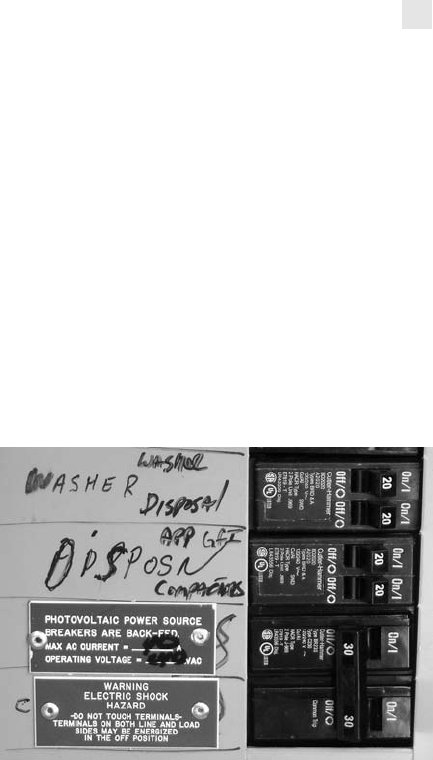
the label warns owners, inspectors, and workers about the potential of the
components to cause or prevent injury.
Photovoltaic Power Source
PV power sources must have permanent labels. Place the preprinted metal label
near the PV disconnect switch. The labels provide information to inspectors and
workers about conductor ampacity and overcurrent protection. According to
NEC 690.53, it should have the following information:
Operating current
Operating voltage
Open-circuit voltage
Short-circuit current
Multiple Power Systems
PV systems with several energy sources that
are interconnected must be labeled with this
information. This is for the safety of anyone
that might work on the system, such as
inspectors or maintenance workers. Illustra-
tions of the interconnection are not
required. However, they may be advanta-
geous. Place the drawing near the PV system
disconnects.
Interactive System Point of Interconnection
Mark and label all interactive system points
of interconnection. Place the information
near the PV system disconnects. Provide the
following information:
Rated AC output current [690.54]
Nominal AC voltage [690.54]
Switches, Fuses, and Circuit Breaker
All switches, circuit breakers, and fuses with open position terminals must be
labeled. The label must warn owners, inspectors, and PV workers that touching
open terminals could cause electric shock.
General
All PV equipment should be labeled with the correct NEC warning signs. All
warning signs should say that electric shock is possible due to high currents.
Circuit breakers should be well labeled to avoid shock.
Courtesy of PerfectPower, Inc.
CHAPTER 6 Standalone PV Systems 135

Every warning sign should state that service is restricted to qualified
personnel.
Warnings around battery boxes should highlight the need to wear personal
protective equipment, and state that people should not smoke nearby because of
the hydrogen gas present.
SOLAR OUTDOOR LIGHTING
R
ural area lights are an example of solar outdoor lighting that is used in “dark” areas on
farms or ranches. Places like livestock pens or barns are lit for days at a time, operating at
times without sunlight.
136 ADVANCED PHOTOVOLTAIC INSTALLATIONS

Chapter 6 Summary
This chapter focuses on PV systems that are not tied to the utility grid, but do have a backup
power source. These standalone PV systems require planning and design that includes distri-
bution systems and modules. The chapter includes information on battery sizing, installation,
and maintenance. It touches on generators, charge controllers, and inverters used in stand-
alone PV systems, the sizing of PV arrays, and component warning labels.
Key ConCeptS and termS
Acid stratification
Battery bank
Charge controller
Charge efficiency
Charge factor
Corrosion
DC voltmeter
Deep discharge protection (DDP)
Depth of discharge (DOD)
Direct coupling
Gassing
Gassing voltage
Hydrometer
Load management system
Maximum Power Point Tracking (MPPT)
Modified sine-wave inverter
Multi-wire branch circuit
Series controller
Shunt controller
Sine-wave inverter
Sludging
Square-wave inverter
Standalone system
State of charge (SOC)
Sulfation
Two-pole circuit breaker
Voltage loss (V
L
)
Chapter 6 aSSeSSment
Standalone PV Systems
1. Coupling DC systems is advantageous for 50kW standalone PV systems.
A. True
B. False
2. Shorting the PV module output terminals temporarily will:
A. destroy the module.
B. do nothing at all.
C. demolish the PV module wiring.
D. obliterate the other PV modules connected in the series.
3. Battery enclosures for lead-acid batteries should have which of the following?
A. Ventilation for hydrogen gas emissions and other corrosive gasses
B. Ventilation at the top of the battery and holes to keep bugs and small animals out
C. Ventilation at the top and bottom of the battery and a plastic tray to contain spills
D. A plastic tray to catch electrolyte spills
CHAPTER 6 Standalone PV Systems 137

4. What type of battery can be used near electronic equipment?
A. Flooded lead-acid
B. Nickel-iron acid
C. Valve-regulated lead-acid
D. Any type of nickel-cadmium
5. What is the main concern when using large wires to decrease voltage drop?
A. Getting the best ratings on DC-rated disconnects
B. Terminals and terminal blocks that are too small for the large wire
C. Acquiring properly rated insulated wire
D. Animals gnawing on the wire
6. Connect the charge controller battery temperature sensor:
A. outside the battery compartment.
B. on the top of the battery.
C. on the bottom of the battery.
D. between two batteries to more accurately gauge battery temperature.
7. Why are sine-wave inverters required for connection to utility lines?
A. They improve the efficiency of the inverters.
B. They provide clean, consistent sine waves and can sync with the grid.
C. They are designed to disconnect from the utility when the power goes off.
D. They are the only inverters capable of utility interconnection.
8. What color are equipment-grounding conductors?
A. White
B. Black
C. Red
D. Green
9. How deep should the working space be for a charge controller with an input voltage
of 60 V?
A. 30 inches
B. 36 inches
C. 42 inches
D. Open to discussion
10. Standby generators should comply with which NEC articles?
A. Article 230 for Electrical Service Requirements
B. Article 250 for General Grounding Requirements
C. Article 445 for Generator Installation Requirements
D. Article 700 for Emergency Power System Safety Installation and Maintenance
Requirements
E. All of the above
138
ADVANCED PHOTOVOLTAIC INSTALLATIONS
..................Content has been hidden....................
You can't read the all page of ebook, please click here login for view all page.
